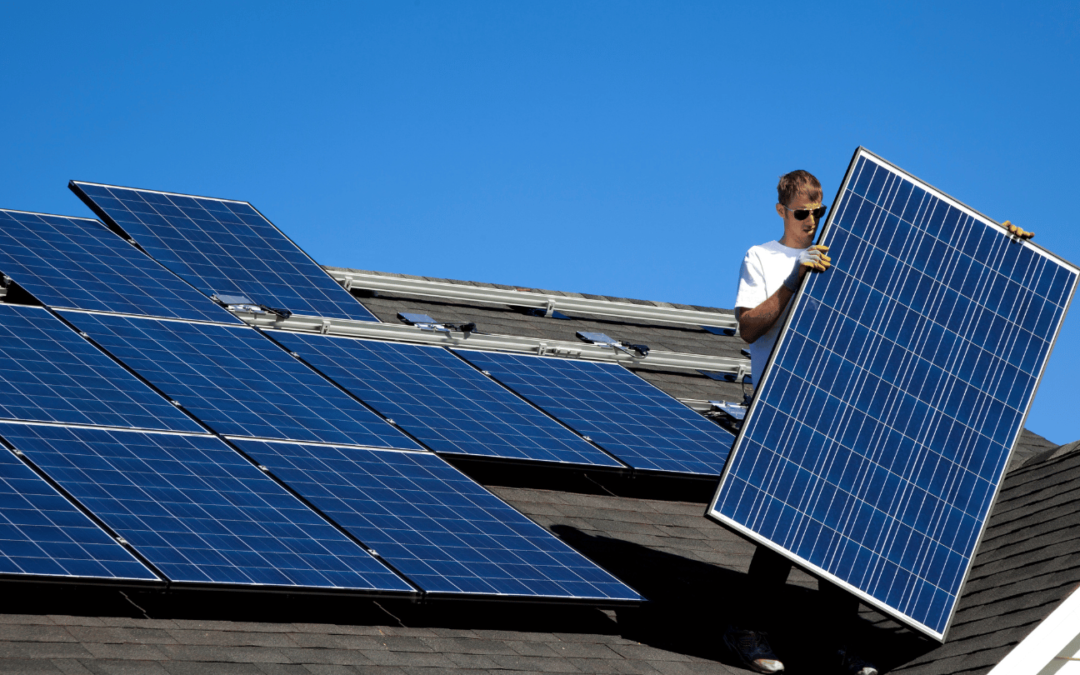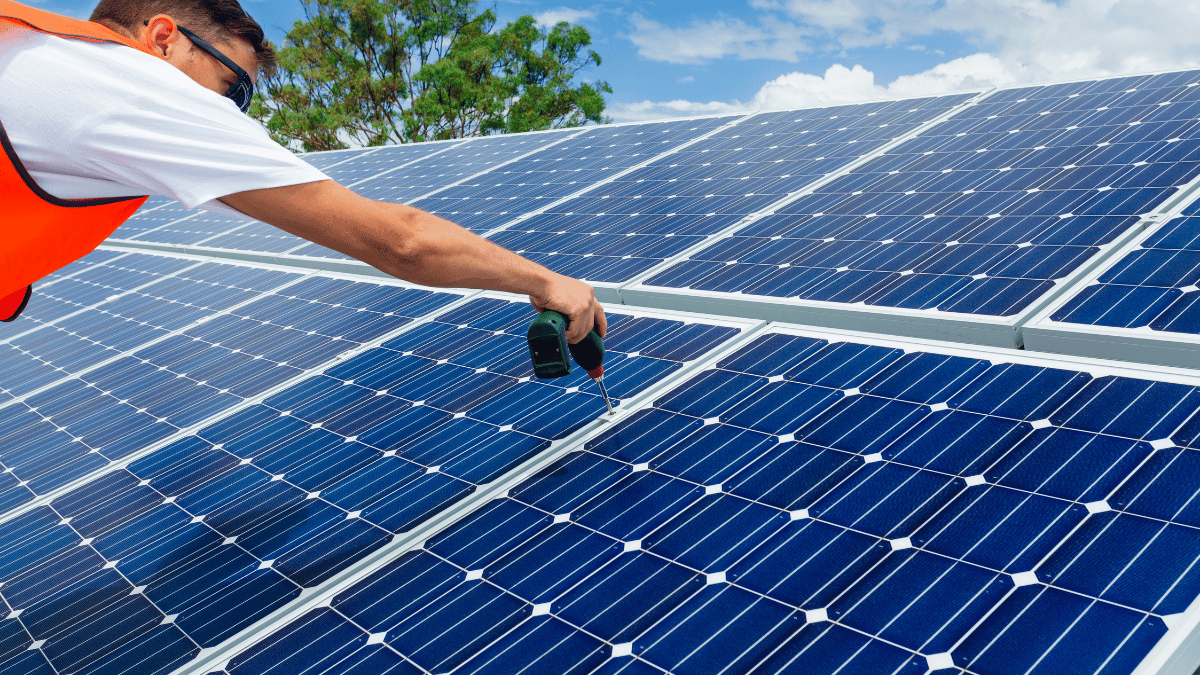Today, we’re diving into the fascinating world of solar panel energy production. Solar power is an incredible renewable energy source, and understanding the ins and outs of how much energy solar panels produce is crucial for those considering this sustainable solution. But how much energy does a solar panel produce?
In this article, we’ll explore that question, along with addressing solar panel size, wattage, output, and more. Ready to make the switch to commercial solar? Let’s get started.
Solar Panel Size and Wattage
Let’s start with the fundamentals of solar panels—size and wattage.
Solar panel size determines how much sunlight they can capture. Similarly, the wattage rating represents their power output. Larger solar panels with higher wattage ratings pack a bigger energy punch, making them ideal for meeting higher electricity demands.
What Do Solar Panels Do?
Have you ever wondered what magic goes on inside those solar panels? Well, wonder no more!
Solar panels are essentially energy transformers. When sunlight hits the panels, they work their wonders, converting sunlight into electricity through a process called the photovoltaic effect.
Explaining The Photovoltaic Effect
The photovoltaic effect is a neat phenomenon that allows solar panels, including commercial ones, to produce electricity from sunlight. Here’s how it works.
- Sunlight Absorption. When sunlight shines on a solar panel, a special material called a semiconductor “soaks up” the sunlight.
- Electron Excitement. The absorbed sunlight makes some tiny particles inside the semiconductor, called electrons, all excited and active.
- Electric Field Creation. This excitement causes the electrons to move around, leaving behind “holes” where they used to be. This movement creates an internal electric field.
- Electricity Generation. When there’s a path for them to move, like metal contacts on the solar panel, the excited electrons, and the holes start moving, creating an electric current.
- Converting to Usable Electricity. The direct current (DC) electricity produced by the solar panel goes through an inverter, which changes it into the type of electricity used in our homes and businesses, called alternating current (AC) electricity.
In commercial solar panels in Orange County, many of these “excited” electrons and electric fields are working together in tandem to produce more electricity. This way, commercial solar panels can generate a lot of clean and renewable energy, making them a fantastic choice for businesses to save on energy costs and be more environmentally friendly.
Solar Panel Output and Energy Production
Now, let’s discuss the crucial aspect of solar panel output. You measure a solar panel’s energy in kilowatt-hours (kWh). This production depends on several factors, such as panel efficiency, location, and shading.
An accurate assessment of solar panel output ensures that you meet energy needs efficiently and sustainably.
How Is Solar Energy Produced?
Remember the photovoltaic effect from before?
Solar energy production begins with the photovoltaic effect. When sunlight hits the solar cells, it generates DC electricity.
An inverter converts this energy into AC to make it usable for homes and Orange County businesses. This clean energy is then ready to power your daily activities, all thanks to the magic of solar panels!
How Is Solar Energy Used?
Solar energy in Orange County has a wide array of residential and commercial applications. From powering homes and businesses to illuminating streetlights and even fueling satellites in space, solar energy is a versatile solution for a cleaner, brighter future. Embracing solar power means taking a significant step toward sustainability and environmental responsibility.
How Many kWh per Day Is Normal?
Ever wondered what’s considered the norm when it comes to solar energy consumption? On average, a typical U.S. household consumes around 30 kWh of electricity per day.
Understanding this baseline helps gauge solar energy system requirements, making it easier to tailor a solution that meets your unique energy needs.
How Big Are Solar Panels?
Worried about gigantic solar panels taking over your rooftop? Fear not! Residential solar panels are relatively compact, often resembling a large painting or a widescreen TV. Although slightly larger, commercial solar panels in Orange County are still designed to fit harmoniously on rooftops or open spaces without overwhelming the surroundings.
Let’s break it down a little further.
Solar panels are available in various sizes to cater to different applications. Commercial solar panels are often larger than their residential counterparts. For instance, the 96-cell panel measures about 41.5 inches by 62.6 inches, while the 72-cell panel is even more sizable at 3.25 feet by 6.42 feet. The larger surface area of these commercial panels allows for greater energy production, making them suitable for powering businesses and large-scale operations.
How Much Energy Does a Solar Panel Produce?
The million-dollar question: how much energy can a single solar panel produce? Well, the answer lies in its wattage, efficiency, and exposure to sunlight. On average, a 250-watt solar panel can generate around 1 to 2 kWh per day. Remember, real-world results may vary depending on location and weather conditions.
But why stop there?
The energy production of a solar panel is influenced by several key factors, making it crucial to consider these aspects when planning a solar energy system. The output rating of a solar panel plays a significant role, with the average panel producing around 170 to 350 watts every hour, equivalent to approximately 0.17 kWh to 0.35 kWh per panel. However, it’s essential to remember that output can vary based on various factors, including the region and weather conditions.
For instance, let’s take an example of a premium solar panel with an output of 290 watts.
If it receives about 5 hours of direct sunlight per day in a sunny state like California, it can generate around 1,450 watt-hours or approximately 1.5 kilowatt-hours (kWh) daily.
For a more specific scenario, consider the following:
- A 400W commercial solar panel in Orange County receives around 4.5 peak sun hours per day.
- This panel can generate 1.8 kWh of electricity daily
- This results in approximately 54 kWh of electricity per month.
It’s essential to recognize that these figures serve as estimates, and the actual energy production will depend on the unique characteristics of the solar panel system. Elements like the total number of panels installed and their combined output will influence the overall energy generation.
To ensure an accurate evaluation of your solar energy needs and to make the most of your solar investment, consider collaborating with a reputable solar panel installer like REPOWER Orange County. We can provide tailored solutions and expert advice to maximize energy efficiency and deliver significant savings for your residential or commercial space.
Solar Panel Sizes and Wattage
Like a tailor-made suit, selecting the right solar panel size and wattage is essential to ensure a seamless fit for your energy needs. A thoughtful approach to panel sizing and wattage guarantees optimal energy production, making the most of your solar investment.
High-Watt Solar Panel
High-watt solar panels are the answer for those aiming to maximize energy production in limited space. These efficient solar panels boast wattage ratings exceeding 400 watts, making them ideal for commercial applications or locations where space is at a premium.
How Much Energy Does A Solar Panel Produce? Final Thoughts
Harnessing the power of solar energy offers a remarkable opportunity to embrace sustainability and reduce your carbon footprint while enjoying substantial long-term savings.
Whether you’re a business owner looking to cut energy costs or a forward-thinking entrepreneur seeking to make a positive impact, REPOWER Orange is here to be your trusted partner in fulfilling your commercial solar panel needs in Orange County. Our experienced team is dedicated to providing tailored solutions, top-notch installations, and ongoing support to ensure a seamless transition to solar power.
Let’s embark on this renewable energy journey together. Contact REPOWER Orange today and take the first step towards a greener tomorrow!
Solar Panel FAQs
We know you have further questions about solar panel efficiency. Here are some common FAQs.
1. How much energy can a solar panel produce in a day?
The energy production of a solar panel varies based on wattage and sunlight exposure, typically ranging from 1 to 2 kWh per day.
2. Can solar panels work during cloudy days?
Yes, solar panels can still produce electricity on cloudy days, although their output may be slightly reduced.
3. Do solar panels require maintenance?
Solar panels require maintenance, with occasional cleaning and checks for optimal performance.
4. How long do solar panels last?
Solar panels can last over 30 years with proper care and maintenance.
5. Can solar panels power an entire home?
Absolutely! A well-designed solar energy system can power an entire home efficiently.
6. Are there government incentives for installing solar panels?
Yes, many regions offer incentives, tax credits, or rebates to encourage solar adoption, making it more affordable.
7. Can I sell excess solar energy back to the grid?
In some areas, net metering programs allow homeowners to sell excess solar energy back to the grid, providing an opportunity for additional savings and a greener impact.


Recent Comments